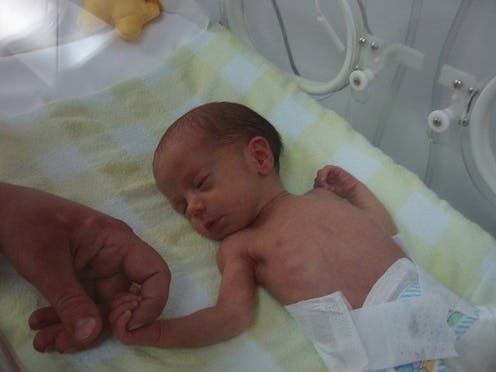News
Why Does America Have So Many Premature Births?

Oh, baby. The rate of babies born prematurely in the United States fell for the sixth year in a row in 2012, reaching a new low of 11.5 percent after peaking at 12.8 percent in 2008. But when placed in a global context, the data in the March of Dimes' inaugural "Born Too Soon: The Global Action Report on Preterm Birth" shows that America still has a long way to go when it comes to preventing premature births.
The definition of a preterm birth is one that occurs before 37 weeks of pregnancy. While more than 60 percent of preterm births in the world occur in sub-Saharan Africa and South Asia, the U.S. falls within the list of 15 countries that account for two-thirds of premature births across the world, thanks in part to preterm rates across the country that vary wildly.
Isolated, America's map is divided into colors based on a grading system of A-F, and as a whole, the United States received a C for premature birth rates. Only six states — Alaska, Oregon, California, Maine, New Hampshire, and Vermont — received an A for a preterm birth rate of less than 9.6 percent. Louisiana, Mississippi, Alabama (as well as Puerto Rico) received Fs with rates greater than 14.6 percent. The South, as a region, fared the worst overall.
It's not easy to compare individual states to various countries, because the ratings scale is different: Much like a stoplight, the world map is divided into red (>15 preterm births per 100), yellow (10-15 preterm births), or green (<10 preterm births).
On the March of Dimes' Global Preterm birth map, the U.S. is colored yellow, the mid-range for premature birth rates. It's a color the United States shares with much of the developing world, including India, most of sub-Saharan Africa, Mongolia, Iran, Afghanistan, Turkey, and Syria. In Europe, only Austria and Moldova have premie birth rates also between 10 and 15 percent.
On the other hand, most "Western" nations — along with countries such as Libya, Kazakhstan, most of South and Central America, Iraq, Thailand and Myanmar — are colored green, which signifies their premature birth rate is below 10 babies for every 100 born.
Ten countries are colored red, meaning that their birth rate is higher than 15 preterm babies per 100 births. These countries — most of which are in sub-Saharan Africa — include Mauritania, Botswana, and Malawi, as well as Indonesia and Pakistan farther east.
1.1 million infants die each year from preterm complications, though most of the causes for preterm births are preventable, or at least reducible. In the United States, the top contributing factor to a premature birth is a lack of good medical care for women, primarily ones who are uninsured. Pregnant women who smoke are the second-highest risk factor, and preterm birth (delivering just a few weeks earlier than the anticipated due date) is the third factor — something that could be reduced by the elimination of early elective deliveries via induction or c-section.
"A premature birth costs businesses about 12 times as much as uncomplicated healthy birth," said March of Dimes President Dr. Jennifer Howse. "As a result, premature birth is a major driver of health insurance costs not only for employers."
Clearly, we've got a broken system here, and babies are suffering.
(Image: César Rincón/Flickr)